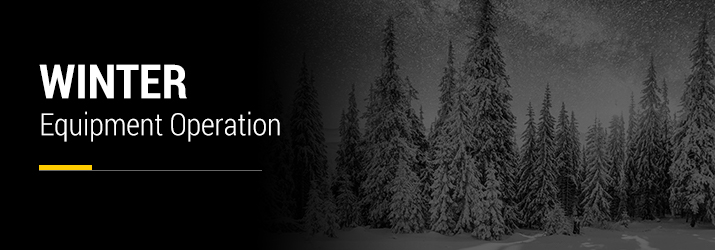
When winter arrives, you and your equipment need to be prepared for extremely low temperatures and harsh outdoor conditions. Before you get caught in the cold, winterize your equipment to protect it from damage. Any equipment being stored for the season should be prepared and protected, or it may not start up again in the spring.
Jump to Section:
- Performing Daily Inspections
- Safe Equipment Operation in Winter
- Operate Equipment Safely in Winter to Prevent Hypothermia
- Storing Equipment Between Uses
- Contact MacAllister for Your Winter Equipment Maintenance Needs
But some companies never rest even in the coldest winters. If your company will be working outside in the winter, it is essential to practice safe and proper cold weather equipment operation. This includes performing daily inspections of equipment as well as regular maintenance to keep your machines working best in the cold conditions.

Performing Daily Inspections
Cold weather can take a toll on even the toughest equipment. It is essential to perform daily inspections of all equipment on your site before use, so you can catch any problems quickly before they turn into something more serious. When giving daily inspections, check all parts of your equipment including:
- Battery
- Tire pressure and tread
- Fluid levels and flow
- Fuel levels
- Build-up on filters
- Lubrication of engine parts, joints and hinges
- Headlights
- Windshield wipers
- Heaters and defrosters
- Brakes
- Body surface and glass
- Undercarriage
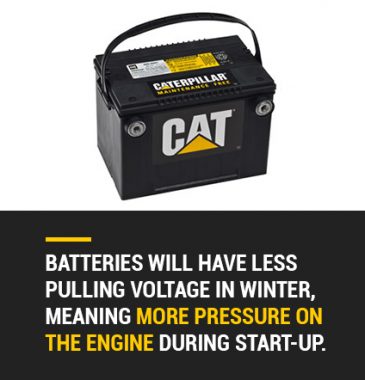 1. Battery Health
1. Battery Health
In cold weather, batteries do not perform as efficiently as they normally do. Batteries will have less pulling voltage in winter, meaning more pressure on the engine during start-up. In weather below freezing, the pressure on the engine can increase by 50 percent. When batteries are weakened by cold conditions, machines may have issues starting or maintaining power. Before each use, be sure that the battery is fully charged. If you need to charge or jump a battery, never do so when the battery is frozen. Allow it to warm up to at least 40 degrees Fahrenheit before charging it. Charging a battery when it is frozen may cause the battery to explode.
Batteries will also charge more slowly in the winter and may die more quickly. Before use, check that there are no signs of corrosion on the cables or connectors of the battery. You should also look out for signs that your machine’s battery may be dying, such as:
- Slow engine crank
- Corrosion on battery posts or cables
- Issues with other electrical components in the machine
- Battery not holding a charge
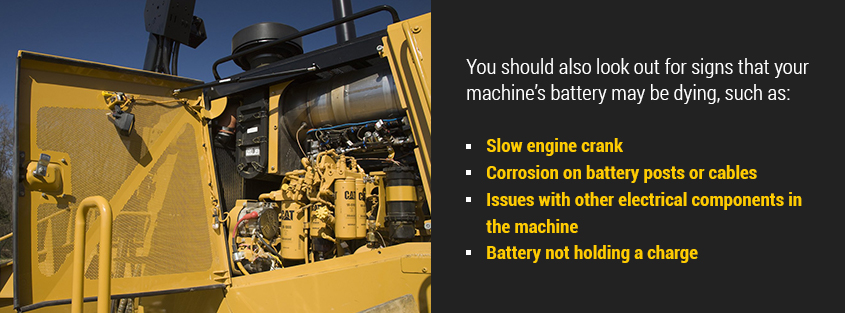
2. Tire Inflation
Check your tire pressure before using a machine to ensure that tires stay fully inflated. Cold weather also makes it more difficult for tires to maintain pressure. Under-inflated tires lead to worse fuel efficiency which means higher operating costs. If tires have low pressure, they will also wear more easily and may be more likely to burst due to brittleness in the winter. When inflating tires, do so in a heated area. Using dry nitrogen in tires can also help eliminate ice crystals. When ice crystals occur, they cause the valve stem to stay open which further increases the deflation rate of the tires.

3. Tire Tread
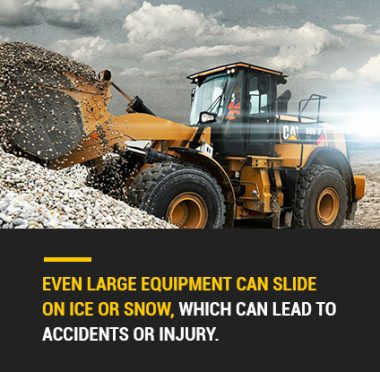 It is extremely important for safe operation of machines in winter that tires have good tread. Even large equipment can slide on ice or snow, which can lead to accidents or injury. Make sure tired tread is appropriate and replace tires if they become too worn down for safe operation in slippery conditions.
It is extremely important for safe operation of machines in winter that tires have good tread. Even large equipment can slide on ice or snow, which can lead to accidents or injury. Make sure tired tread is appropriate and replace tires if they become too worn down for safe operation in slippery conditions.
4. Fluids
Even when you are using the proper winter fluids in your equipment, extremely cold weather can cause fluids to thicken which increases the pressure on seals and hoses. If fluids freeze or become too thick, they can cause hoses, which are already more brittle in cold weather, to burst. When inspecting fluids, check fluid levels and viscosity by checking the dipstick. If the fluid drips, it is fluid enough. You should also look for signs of leaks that could indicate cracks in seals or hoses.
As part of the winterizing process, you should change the oil in your machine to a synthetic base multi-grade oil so that it will flow better in colder temperatures, posing less risk of solidifying and clogging filters.
To ensure good health of the fluids in your Cat® equipment, it is best practice to perform preventative analysis before winter. Our S.O.S. fluid analysis services can identify any issues with your coolant and oil before they shut down your machines.
5. Filter Replacement
Be sure to check all filters as dirty or clogged filters can impact a machine’s ability to start or cause it to lose power in the middle of a job. If a machine loses power during operation in the winter, it may be stuck in ice and snow that would lead to further damage to the machine.
6. Fuel Filters and Fuel Gelling
Diesel particulate filters are extremely important to check carefully in the winter as colder temperatures will affect the emissions system of your machines. If there is any free water in your fuel tank, it can freeze and create ice crystals. These crystals can cause wear on your fuel systems or clog filters and pipes. To reduce the potential for free water to collect in your fuel tank, top off the fuel tank daily to prevent condensation from building in the tank.
Another major cause of clogged filters in the winter is fuel gelling. Gelling occurs when compounds in the fuel reach their freezing point then turn into thick, waxy solids. These soft solids can coat and block filters. Diesel fuel is a mixture of around 250 chemicals, most of which are hydrocarbons. Each hydrocarbon has a different freezing point, but a good winter diesel will contain a mixture of hydrocarbons with lower freezing points. Be sure your winter diesel is number 1 diesel (1–D) or a mixture of 1-D and 2-D.
You should also be aware of the Cold Filter Plugging Point, or CFPP, of your fuel. The CFPP is the temperature at which wax will form crystals that drop out of the diesel and clog fuel filters. If operating your machines in temperatures lower than the CFPP, be sure to allow proper warm-up time and avoid storing your equipment overnight in cold conditions.
If you are using biodiesel in your machines, you face an additional risk of glycerin solids forming in your fuel tanks. Glycerin is a byproduct created in biodiesel production that is removed from the fuel before use. However, even a small amount of glycerin left in biodiesel can cause major issues for your equipment operation in winter. When glycerin freezes, it clogs fuel filters just as gelled fuel does, however, glycerin will not become liquid again once the temperature rises above its freezing point. Instead, the glycerin will remain solid in your fuel tank, preventing fuel from flowing even after it warms up.

When gelling or glycerin build-up occurs on a fuel filter, it can be difficult to notice if you are not looking for it. Soft solids will form a waxy coating over the filter and can sometimes collect in the filter can, but the filter itself may appear clean. Be sure to look out for waxy build-up on your diesel fuel filters and change filters before clogged fuel flow causes your machines to break down or be unable to start in the morning.
7. Fuel Levels
It is best practice to top off your fuel every night so moisture will not collect in the tank. This will prevent the formation of ice crystals inside of your machine. It is also best to empty the water separator daily so it does not have a chance to freeze. Your fuel rating should be 40 Cetane or higher in the winter and 50 Cetane or higher when temperatures go below zero.
8. Lubrication
Any moving parts of your vehicle should remain properly lubricated as cold weather can cause parts to freeze or stick. This can halt processes and cause damage to the machine if parts jam during operation. Check all joints and hinges daily for proper lubrication.

9. Lights and Wipers
Checking that all lights and wipers on equipment are functional becomes even more important in the winter. Winter months tend to bring lower light levels, more condensation and more precipitation. In these poor-visibility conditions, it is essential that lights are kept clean and bad headlights are replaced immediately.
10. Heaters and Defrosters
For the comfort and safety of your employees, the defrosters and heaters in all machine cabs must be functional. Defrosters ensure that visibility can be maintained even in poor winter weather. Maintaining a comfortable temperature inside machines allows operators to move properly as extreme cold temperatures can cause muscles to stiffen which impairs proper operating.
11. Check Brakes
In winter weather, equipment is more likely to slip or skid so it is essential that brakes are working in top condition.
12. Surface Damage or Cracks in Glass
If there are any cracks in the glass of a windshield or window, these can become a serious issue in the winter when moisture seeps into cracks and freezes. The expansion of the ice will cause even small cracks to spread and could lead to the glass shattering. Small paint chips on equipment surfaces can lead to the machine rusting if it is left out in the snow or ice. Be sure to identify and repair any surface damage to machines before it becomes a bigger issue.
Safe Equipment Operation in Winter
Winter poses new risks to take into account when operating your Cat equipment. To avoid damaging your machinery during winter months, follow these winter safety tips for equipment operators:
- Allow your vehicle to fully warm-up: Wires and pipes can become brittle in the winter, so it is essential to allow your equipment to warm up fully to operating temperature before each use. If machines do not have time to warm up, pipes could burst or exhaust and intake valves could stick.
- Use block heaters or starting fluid: Block heaters increase the temperature of your engine and hydraulic fluid so your equipment can warm up more quickly. Starting fluid can also be used when the engine is cranking to get equipment running. Starting fluid is extremely flammable and should be stored at room temperature when not in use.
- Drive carefully: Snow can conceal hazards on the ground, such as ditches or uneven ground. Be sure to clear a path for vehicles and apply grit where there is frequent vehicle traffic. Be extra cautious if working near bodies of water, as ice could be hidden under snow and may not hold the weight of your machine. Icy conditions can cause machines to slip or slide into structures, other machines or workers. Driving slowly and carefully is essential when ground conditions are slippery in the winter.
- Know your work site: When weather and ground conditions are not ideal, it is important to know your work site and its terrain. Be aware of areas that are likely to be slippery or icy and organize your work-flow to reduce the risk of an accident. Be aware that ramps and bridges will freeze first, so take extra caution when operating machines on elevated surfaces.
- Slow down: When ground conditions are slippery, machines need more time to stop or turn safely. Driving slowly also allows more time for operators to react if a machine begins to slide on ice. When the ground freezes, it becomes brittle, so driving slowly can reduce the risk of popping a tire or harming the machine from impact with sharp frozen earth.
- Work when visibility is clear: With shorter daylight hours in the winter, it can be tempting to work during dark hours of the day. However, having good visibility becomes even more essential when operating equipment during winter, as ice can be difficult to see and snow can conceal ground hazards. Headlights alone may not be sufficient to see ice or slush on the ground, so consider using additional lighting sources. If you must work at night, ensure there is ample lighting in all areas of the work site. Windshields will often be icy or foggy, so ensure that defrosters are always running functionally.
- Be realistic: Winters in Indiana and Michigan can become so cold that some job tasks may not be possible or may cause too much strain on your machines to be worth the risk. Be realistic about what tasks can be completed in winter weather and plan around warmer days and days where precipitation is not predicted. It is also best to schedule working hours around the warmest time of day whenever possible.
- Plan for bad weather: Winter weather conditions can sometimes change quickly from rain to ice or hail. Be sure your employees are properly trained on how to react to changes in temperature and weather. Operators should be able to discern when it is safe to keep working or when they should shut down due to poor conditions. You should also have a written plan for severe weather such as a hailstorm or blizzard. Train employees on how to respond to all severe weather events that are possible in your area and post your severe weather plans in a location where all employees can easily refer to them. Being prepared for severe weather is the best way to prevent your equipment from damage.
Operate Equipment Safely in Winter to Prevent Hypothermia
Just as it is essential to protect your equipment from harsh winter conditions, your workers must also take precautions to protect against the risks of winter. Hypothermia or frostbite become major risks when workers are exposed to cold conditions for a long duration of time.
When a person’s body temperature falls below 95 degrees Fahrenheit, hypothermia can occur, leading to shivering, difficulty breathing, a weak pulse, dizziness, slurred speech or loss of coordination. If you notice any of these symptoms, take the person indoors and ensure they are kept warm and dry until emergency help can arrive. Hypothermia can cause a person to become unconscious if body temperature drops below 82 degrees Fahrenheit, and can be fatal if not addressed quickly.
Frostbite occurs when a person’s skin is exposed to cold temperatures and the tissues freeze. Frostbite is recognizable by tingling, numbness or itching in infected regions, often in hands or feet. These sensations are often accompanied by redness or waxy white skin. If a worker experiences frostbite, they should keep the affected area dry and covered and seek medical help. Frostbite can often accompany hypothermia and can cause complete tissue death.

One of the simplest ways to prevent hypothermia or frostbite is to dress appropriately. Almost 90 percent of heat loss occurs through the skin, making it essential to have as little skin exposed to the cold as possible. Equipment operators should wear warm layers, ideally made from materials that wick away moisture. Gloves and boots should be insulated and waterproof to keep hands and feet dry. Gloves should be flexible to ensure that equipment can still be operated safely. Boots should also have appropriate grips that reduce the risk of slipping on ice or snow. If goggles or glasses are worn, they should have an anti-fog coating so they do not collect condensation that impairs vision. As always, it is important to consider how clothing will impact your ability to operate a machine. Clothing should never be loose, as that poses risks of getting caught in a machine. Overly bulky clothing can also impede movement and make operators clumsier. Opt for tightly fitting insulated layers that allow operators to move as necessary while staying warm.
It is also essential to allow your employees to take breaks more frequently when operating machines in extremely cold weather. Workers should warm up and drink liquids, as it is easy to forget to stay hydrated in colder temperatures. Dehydration can cause dizziness and headaches that can impair the ability to operate machines and can be dangerous if not addressed.
Other important safety precautions to take in the winter are to walk carefully and never touch metal surfaces with bare hands. Grip plates and metal surfaces can become icy, making slips more likely. When inspecting equipment or entering and exiting cabs, take extra caution. Touching metal with bare skin in the winter can cause painful cold burns. Perform equipment inspections with gloves on or while the machine is indoors and warmed up.
Storing Equipment Between Uses
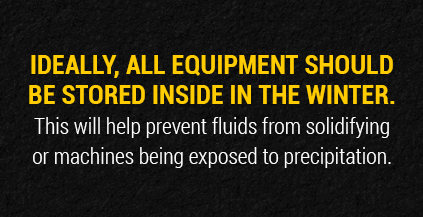 Ideally, all equipment should be stored inside in the winter. This will help prevent fluids from solidifying or machines being exposed to precipitation. If your equipment is too large to move indoors at night, park it on wooden planks, platforms or another raised surface. Parking your vehicle on the ground can cause it to freeze to the dirt or in its own tire tracks, even if you are only leaving it overnight. When workers start up the equipment in the morning, they can put stress on the tires. As previously mentioned, tires are already prone to becoming under-inflated or brittle in cold weather, so extra pressure could cause them to crack or wear more quickly. If storing equipment outside, always park with the bucket or blade lifted from the ground as these are also likely to freeze to the ground.
Ideally, all equipment should be stored inside in the winter. This will help prevent fluids from solidifying or machines being exposed to precipitation. If your equipment is too large to move indoors at night, park it on wooden planks, platforms or another raised surface. Parking your vehicle on the ground can cause it to freeze to the dirt or in its own tire tracks, even if you are only leaving it overnight. When workers start up the equipment in the morning, they can put stress on the tires. As previously mentioned, tires are already prone to becoming under-inflated or brittle in cold weather, so extra pressure could cause them to crack or wear more quickly. If storing equipment outside, always park with the bucket or blade lifted from the ground as these are also likely to freeze to the ground.
It is also very important to keep your machines clean from salt and snow in the winter. Salt that sticks to the machine at the end of the night can lead to rust or erosion if not removed. Snow and debris can get caught in the undercarriage, so it is important to always clean vehicles before moving them indoors or turning them off for the evening. When vehicles are stored outside, the undercarriage should be checked for snow or ice before starting up in the morning.
If you cannot store your equipment inside, you should drain all fluids or store fluids somewhere they can be kept at room temperature whenever possible. Your battery should also be stored indoors to prevent it from cold damage. Batteries are one of the most vulnerable parts of machines in the winter, so they should be kept warm and fully charged as much as possible.
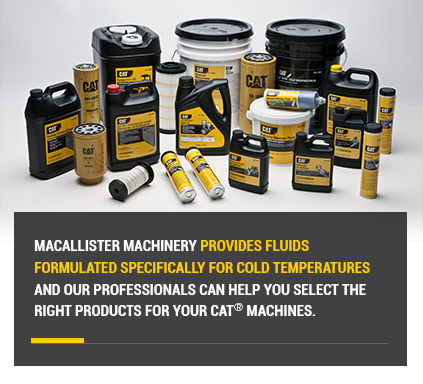 Contact MacAllister for Your Winter Equipment Maintenance Needs
Contact MacAllister for Your Winter Equipment Maintenance Needs
Keeping up with regular maintenance during the winter will ensure your Cat equipment has a long life and stays in top condition. Follow these cold weather service recommendations to prevent problems common in winter. Keep your machines and employees safe by topping off fluids, driving safely and staying prepared for anything the season can throw at you.
MacAllister Machinery provides fluids formulated specifically for cold temperatures and our professionals can help you select the right products for your Cat machines. MacAllister has every Cat part you need to take care of your machines so they can power through the winter.
Contact MacAllister Machinery to schedule an inspection, so your equipment is prepared for the harsh Michigan and Indiana winters. We are right around the corner for all of your parts and service needs. Don’t let your machines succumb to the cold — give MacAllister Machinery a call.
